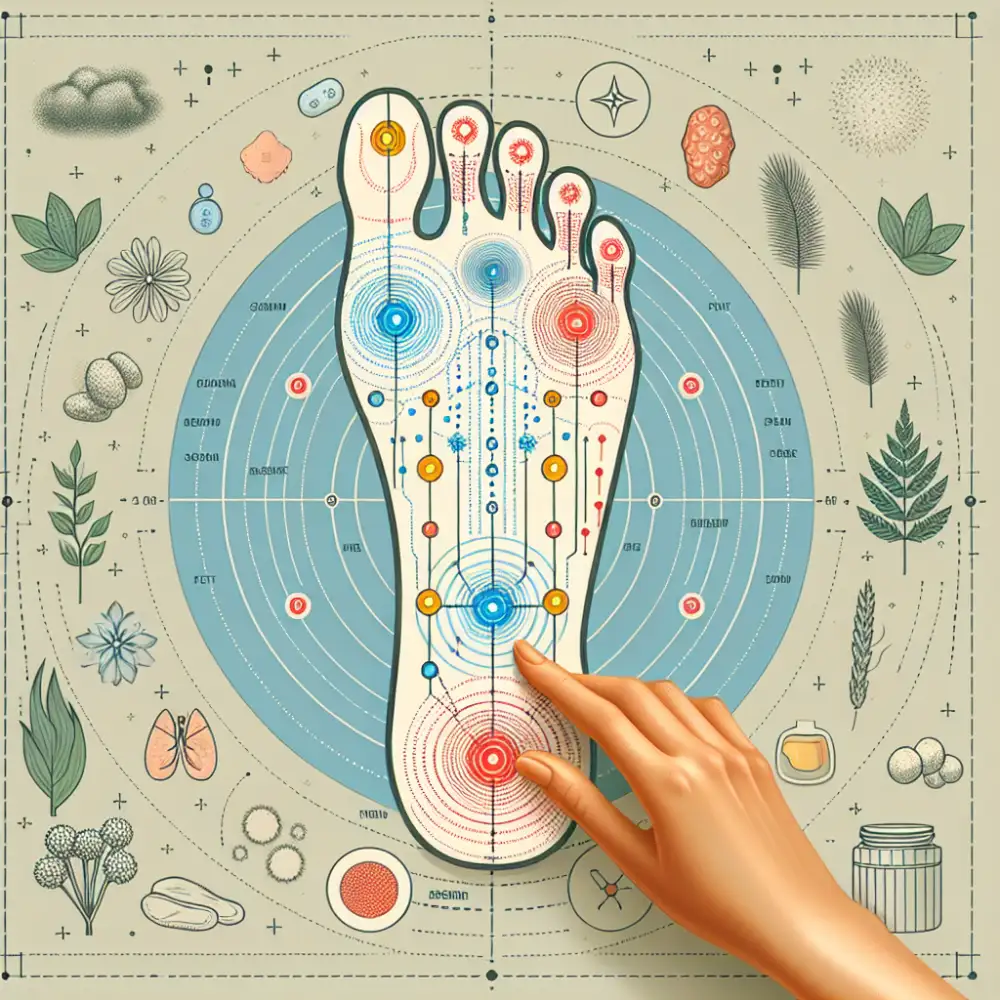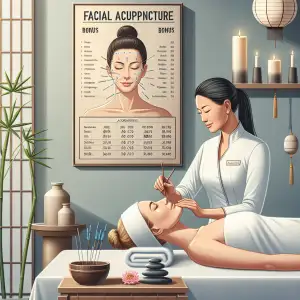Can Reflexology Kick Your Allergies to the Curb?

What is reflexology?
Reflexology is a complementary therapy that involves applying pressure to specific points on the feet, hands, or ears. These points are believed to correspond with different organs and systems in the body. By stimulating these reflex points, reflexologists aim to promote relaxation, improve circulation, and encourage the body's natural healing processes. While reflexology is not a cure for allergies, many people find it helpful in managing allergy symptoms. Allergies occur when the immune system overreacts to harmless substances called allergens, such as pollen, dust mites, or pet dander. This immune response triggers the release of histamine and other chemicals, leading to symptoms like sneezing, runny nose, itchy eyes, and skin rashes.
Reflexology may help alleviate allergy symptoms by:
- Reducing stress and promoting relaxation: Stress can exacerbate allergy symptoms. Reflexology's relaxing effects may help reduce stress hormones, potentially easing allergy symptoms.
- Improving lymphatic drainage: The lymphatic system plays a crucial role in removing toxins and waste products from the body. Reflexology may stimulate lymphatic flow, helping to clear allergens and reduce congestion.
- Reducing inflammation: Allergies involve an inflammatory response. Reflexology may help reduce inflammation by promoting blood flow and reducing the release of inflammatory chemicals.
While reflexology can be a valuable complementary therapy for allergy relief, it's essential to remember that it's not a substitute for conventional medical treatment. If you have allergies, consult a healthcare professional for proper diagnosis and treatment. Reflexology can be used alongside conventional allergy management strategies, such as medications and allergen avoidance, to provide a holistic approach to allergy relief.
Reflexology and allergies
Reflexology is a complementary therapy that involves applying pressure to specific points on the feet, hands, or ears. These points are believed to correspond to different organs and systems in the body. While reflexology is not a cure for allergies, some people find that it helps to manage their symptoms.
Allergies occur when the immune system overreacts to a harmless substance, such as pollen, dust mites, or pet dander. This triggers the release of histamine and other chemicals, which cause symptoms such as sneezing, runny nose, itchy eyes, and skin rashes.
Reflexology is thought to work by stimulating the nervous system and promoting relaxation. This may help to reduce stress, which can be a trigger for allergies. Some studies suggest that reflexology may also help to reduce inflammation and boost the immune system.
During a reflexology session, a trained therapist will apply pressure to specific points on the feet, hands, or ears. The amount of pressure applied will vary depending on the individual's needs. Reflexology is generally a very relaxing experience, and many people find that it helps to reduce stress and promote a sense of well-being.

If you are considering trying reflexology for allergies, it is important to find a qualified and experienced therapist. Reflexology is a complementary therapy and should not be used as a substitute for conventional medical treatment. It is always best to consult with your doctor before starting any new treatment, especially if you have any underlying health conditions.
Reflexology can be a valuable tool in managing allergies, helping to restore balance and promote the body's natural healing abilities.
Clementine Blackwood
How does it work?
Reflexology operates on the principle that specific points on the feet, hands, and ears correspond to different organs and systems in the body. These points are believed to be energetic pathways. By applying pressure to these reflex points, reflexologists aim to stimulate nerve endings and improve energy flow, promoting healing and balance within the corresponding areas.
When it comes to allergies, reflexology views them as an overreaction of the immune system. It suggests that allergens trigger an imbalance in the body's energy flow. Reflexology for allergies focuses on specific reflex points related to the immune system, lymphatic system, and organs involved in allergic responses, such as the sinuses, lungs, and digestive system.
During a reflexology session for allergies, the practitioner uses their thumbs and fingers to apply targeted pressure to these reflex points. This pressure is believed to help alleviate allergy symptoms by:
Reducing congestion and inflammation in the sinuses and respiratory system
Supporting the lymphatic system in removing toxins and allergens
Balancing the immune system's response to allergens
Promoting relaxation and reducing stress, which can exacerbate allergy symptoms
While reflexology for allergies is generally considered safe, it's essential to consult with a qualified reflexologist, especially if you have any underlying health conditions. Reflexology should not be used as a substitute for medical treatment but rather as a complementary therapy to support overall well-being.
Benefits of reflexology
Reflexology is a complementary therapy that involves applying pressure to specific points on the feet, hands, or ears. These points are believed to correspond to different organs and systems in the body. While reflexology is not a cure for allergies, many people find it to be a helpful complementary therapy for managing allergy symptoms.
One of the main benefits of reflexology for allergies is its ability to reduce stress. Allergies can be triggered or worsened by stress, so managing stress levels is important for allergy relief. Reflexology promotes relaxation and reduces stress by calming the nervous system. By reducing stress, reflexology may help to prevent or reduce the severity of allergy symptoms.

Reflexology may also help to improve lymphatic drainage. The lymphatic system plays a crucial role in removing toxins and waste products from the body. Allergies can sometimes put a strain on the lymphatic system. Reflexology is thought to stimulate the lymphatic system, helping to improve lymphatic drainage and remove allergens from the body.
Furthermore, reflexology may help to reduce inflammation. Allergies often involve an inflammatory response in the body. Reflexology is believed to have anti-inflammatory effects, which may help to reduce swelling and inflammation in the sinuses, nasal passages, and airways.
It's important to note that reflexology should not be used as a substitute for medical treatment. If you have allergies, it's essential to consult with a qualified healthcare professional for diagnosis and treatment. Reflexology can be used as a complementary therapy alongside conventional medical care.
| Feature | Reflexology for Allergies | Conventional Allergy Treatment |
|---|---|---|
| Mechanism of Action | Based on the theory that pressure points on the feet correspond to other areas of the body and can stimulate healing. | Targets specific allergic responses using medications or immunotherapy. |
| Scientific Evidence | Limited and inconclusive; more research needed. | Strong scientific evidence and established efficacy. |
| Side Effects | Generally considered safe with minimal side effects, though some may experience temporary soreness. | Can vary depending on treatment; may include drowsiness, dry mouth, or more serious reactions in some cases. |
Reflexology for allergies relief
Reflexology is a complementary therapy that involves applying pressure to specific points on the feet, hands, or ears. These points are believed to correspond to different organs and systems in the body. While reflexology is not a cure for allergies, many people find that it can help to relieve allergy symptoms.
Reflexology is thought to work by stimulating the nervous system and promoting relaxation. When the body is relaxed, it is better able to cope with stress and inflammation, which can trigger allergy symptoms. Some people with allergies find that reflexology helps to reduce the severity and frequency of their symptoms. Others find that it helps them to feel more relaxed and better able to cope with their allergies.
If you are considering trying reflexology for allergies, it is important to find a qualified and experienced practitioner. You should also talk to your doctor to make sure that reflexology is right for you. Reflexology is generally considered safe for most people. However, it is important to avoid reflexology if you are pregnant, have a history of blood clots, or have any open wounds on your feet.
While reflexology can be a helpful complementary therapy for allergies, it is important to remember that it is not a substitute for conventional medical treatment. If you have allergies, it is important to see a doctor to get a diagnosis and discuss treatment options.
What to expect
If it’s your first time trying reflexology for allergies, you might wonder what’s in store. During a session, you’ll relax on a comfortable chair or table. The reflexologist will gently massage and apply pressure to specific points on your feet, hands, or ears that correspond with your respiratory system and immune system.

Don’t worry, it shouldn’t hurt! While you might feel some tenderness in certain areas, it should generally be a relaxing and enjoyable experience. Many people report feeling deeply relaxed during and after a session.
As for the effects, some people experience relief from allergy symptoms like congestion, sneezing, and itchy eyes after just one session. However, it’s important to remember that everyone responds differently, and multiple sessions are often recommended for optimal results. Reflexology is often seen as a complementary therapy, meaning it can be used alongside traditional allergy treatments.
Always consult with your doctor or allergist before starting any new treatment, including reflexology.
Choosing a reflexologist
When seeking relief from allergies through reflexology, finding a qualified and experienced practitioner is crucial. Look for a reflexologist who is registered with a reputable professional organization. This ensures they have met specific training and ethical standards. Inquire about the reflexologist's experience in treating allergies. While reflexology can be a complementary therapy, it's essential to discuss any existing medical conditions or treatments you're undergoing with your doctor. They can help determine if reflexology is appropriate for your specific situation and provide guidance on integrating it into your overall allergy management plan.
Remember that reflexology is a complementary therapy and should not replace conventional medical treatment for allergies. Always consult with your doctor for diagnosis and treatment of any health concerns.
Risks and considerations
Combining with other therapiesReflexology is often used alongside other therapies to support overall well-being. It's not a replacement for conventional allergy treatments. Talk to your doctor about incorporating reflexology into your allergy management plan. They can help you determine the best course of action and ensure it complements your existing treatments. This integrative approach may involve combining reflexology with antihistamines, nasal corticosteroids, or immunotherapy. Your doctor might also suggest other complementary therapies like acupuncture or herbal remedies. Remember, managing allergies is about finding what works best for you. Open communication with your healthcare provider is key to developing a safe and effective treatment strategy.
Research and effectiveness
Despite the popularity of reflexology as a complementary therapy for various health conditions, including allergies, scientific evidence supporting its effectiveness in treating allergies remains limited.

Some small studies suggest that reflexology may help reduce allergy symptoms such as congestion, sneezing, and itching. These studies propose that applying pressure to specific reflex points on the feet, hands, or ears may influence the nervous system and potentially modulate immune responses. However, these studies often have methodological limitations, including small sample sizes, lack of control groups, and subjective outcome measures.
Larger, well-designed clinical trials are necessary to establish the true efficacy of reflexology for allergy relief. These trials should include standardized protocols, appropriate control groups, and objective outcome measures to assess changes in allergy symptoms, medication use, and quality of life.
It is important to note that reflexology should not be considered a replacement for conventional allergy treatments prescribed by healthcare professionals. If you are considering using reflexology for allergies, it is crucial to consult with a qualified healthcare provider to discuss its potential benefits and risks and to ensure it complements your existing allergy management plan.
While reflexology shows promise as a complementary therapy for allergy relief, it is crucial to approach it with a balanced perspective. Reflexology should not be seen as a replacement for conventional allergy treatments prescribed by medical professionals. Instead, it can be viewed as a complementary practice that may help manage allergy symptoms and improve overall well-being. More research is needed to establish definitive conclusions about its effectiveness. If you are considering reflexology for allergies, consult a qualified reflexologist or healthcare provider. They can provide personalized guidance and ensure it aligns with your overall health strategy. Remember, managing allergies is an ongoing process, and integrating various approaches under professional supervision can lead to a more holistic and effective outcome.
Published: 07. 07. 2024
Category: Food



